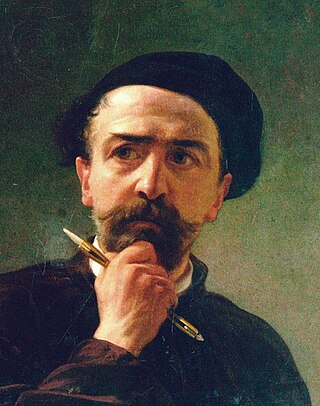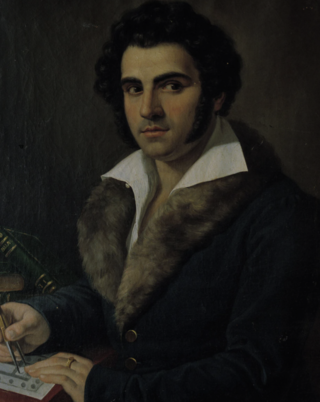
(date unknown)
Salvino Salvini (26 March 1824, Livorno - 4 June 1899, Arezzo) was an Italian sculptor; best known for his grave monuments.

Salvino Salvini (26 March 1824, Livorno - 4 June 1899, Arezzo) was an Italian sculptor; best known for his grave monuments.

He was born to a family of modest origin. His father wanted him to receive a classical education but, at the age of twelve, he was inspired to pursue a career in art when he saw a statue by Paolo Emilio Demi . Two years later, he was able to attend free drawing classes offered by a local artist and created his first clay busts. [1]
In 1840, he was admitted to the Accademia di Belle Arti di Firenze, where he initially studied with Giovanni Dupré. He eventually found his mentor in Lorenzo Bartolini. [2] Although they often clashed, in 1849 he was able to go to Rome to study with Pietro Tenerani, largely on the basis of Bartolini's recommendation. [3] In 1852, Tenerani used his influence with Grand Duke Leopold II to obtain an appointment for Salvini as Professor of Ornamentation at the Accademia di Belle Arti in Pisa. [1]
During his time there, he was also appointed to the position of Export Inspector for the Grand Duchy of Tuscany. In this capacity, he was called upon to validate the authenticity of several major art works, including a bust of Calliope by Antonio Canova. In 1855, he married Cesira Montemerli, a noblewoman, and they had two children.
Six years later, he was named to succeed Cincinnato Baruzzi at the Accademia di Belle Arti di Bologna [3] His first major work there was a statue of Saint John the Evangelist for the façade of the Basilica di Santa Croce (1862). That same year, he became a Professor. In 1867, he was awarded the Cross of the Order of Saints Maurice and Lazarus. [1] In 1874, he became a member of the Società Benvenuto Tisi da Garofalo , a cultural organization in Ferrara. There, he sat as a judge of the works of young sculptors seeking admission to the "School of Drawing for Arts and Crafts". [3]

Also worthy of mention is a statue of the thirteenth-century Cardinal, Pietro Valeriano, for the façade of the Cattedrale di Santa Maria del Fiore (1876). His notable students included Giovan Battista Longanesi-Cattani , Diego Sarti , Tullo Golfarelli, Enrico Barberi and Pasquale Rizzoli. [3]
In 1890, he began to suffer from a progressive paralysis and was forced to stop teaching. He was retired by royal decree in 1893, and moved to Arezzo. In 1895, he was named a Commander in the Order of the Crown of Italy. [1] The city of Livorno named a street after him in 1938.

Pietro Canonica was an Italian sculptor, painter, opera composer, professor of arts and senator for life.

The Accademia di Belle Arti di Bologna is a public tertiary academy of fine art in Bologna, in Emilia-Romagna in northern Italy. It has a campus in Cesena.

The Accademia di Belle Arti di Venezia is a public tertiary academy of art in Venice, Italy.

Enrico Pollastrini was an Italian history painter and art school director.

Carlo Arienti was an Italian painter; known primarily for historical and Biblical scenes.

Pietro Bardellino was an Italian painter in the Rococo style.

Pio Fedi was an Italian sculptor who worked chiefly in the Romantic style.

Tommaso Minardi was an Italian painter and author on art theory, active in Faenza, Rome, Perugia, and other towns. He painted in styles that transitioned from Neoclassicism to Romanticism.

Giuseppe Sogni was an Italian painter, known for portraits and historical scenes.

Annibale Angelini was an Italian painter and scenographer.
Fedele Caggiano was an Italian sculptor, active in styles spanning both neoclassical and Romantic periods.
Mario Salvini was an Italian ceramist and sculptor.

Giuseppe Ciaranfi was an Italian history and genre painter.

Tommaso Gazzarrini was an Italian painter born in Livorno, who painted religious and historic subjects in a Neoclassic style.

Pietro di Giovanni Lianori was an Italian painter, active in Bologna.
Pasquale Romanelli was an Italian sculptor, and apprentice of Lorenzo Bartolini.

Giuseppe Isola was an Italian painter.

Niccolò "Nicola" Matas was an Italian architect and professor. He is best known for being the architect of the 19th century Gothic Revival façade of the Basilica of Santa Croce in Florence, Italy. Matas was a professor at the Academy of Fine Arts, Florence. He is one of the important architects in the history of the city of Florence.

Antonio Cipolla was an Italian architect, active in an academic neo-Renaissance style.

Tullo Golfarelli was an Italian sculptor and painter.